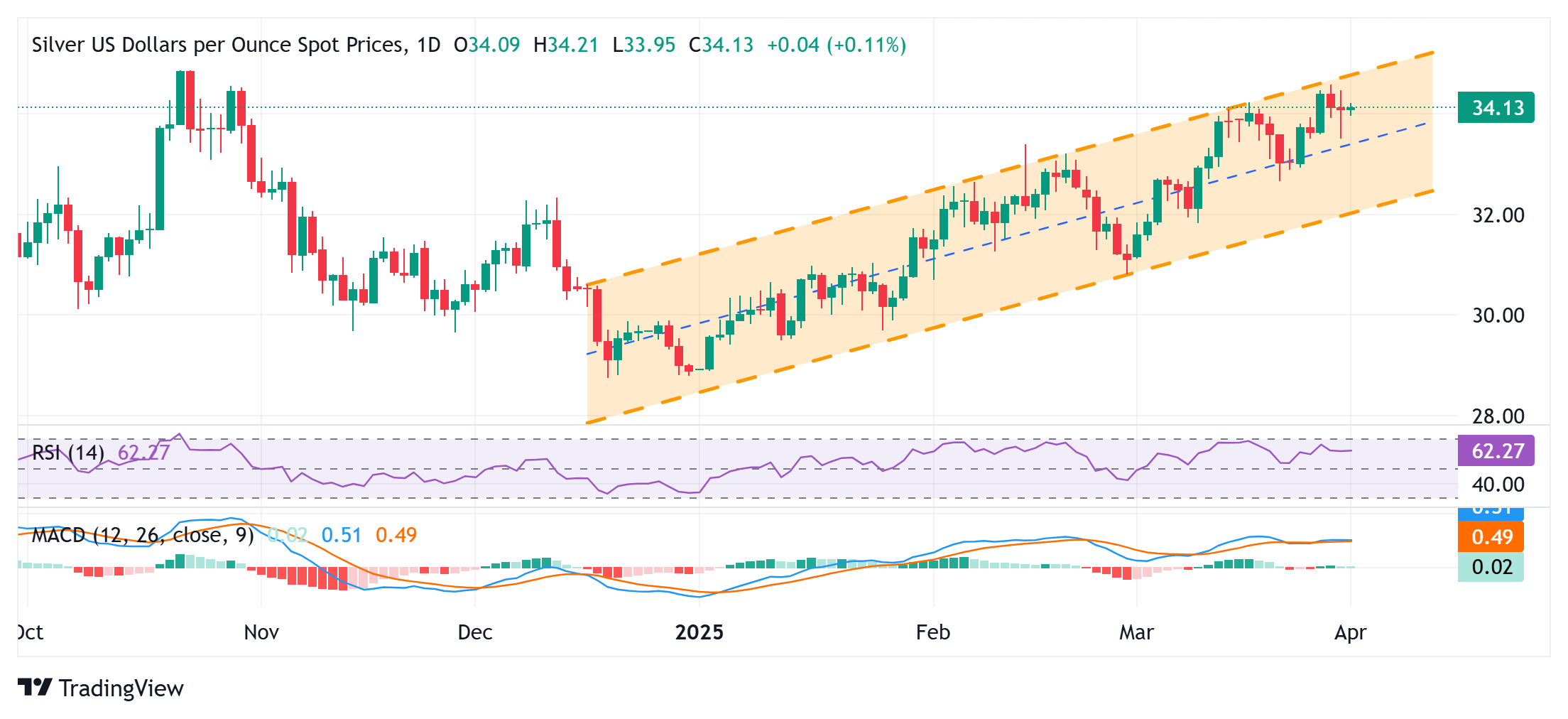Silver Price Forecast: XAG/USD holds steady above $34.00, seems poised to climb further
- Silver struggles to gain any meaningful traction and remains confined in a range.
- The technical setup favors bulls and supports prospects for further appreciation.
- Dip-buying near mid-$33.00s should help limit any meaningful corrective decline.
Silver (XAG/USD) oscillates in a narrow trading band following the previous day's good two-way price moves, though it holds above the $34.00 mark through the Asian session on Tuesday. Moreover, the white metal remains close to a multi-month high, around the $34.60 area touched last Friday.
Looking at the broader picture, the recent strong positive move witnessed since the beginning of 2025 has been along an upward-sloping channel. This points to a well-established short-term uptrend. Furthermore, oscillators on the daily chart are holding comfortably in positive territory and are still away from being in the overbought zone. This, in turn, suggests that the path of least resistance for the XAG/USD is to the upside.
Hence, a move beyond the year-to-date high around the $34.60 area, towards retesting a multi-year peak near the $34.85 region touched in October, looks like a distinct possibility. The latter now coincides with the top boundary of the aforementioned trend channel, which if cleared decisively will be seen as a fresh trigger for bulls and set the stage for a further near-term appreciating move for the XAG/USD.
On the flip side, any corrective pullback might continue to attract some dip-buyers and remain limited near the overnight swing low, around mid-$33.00s. A convincing break below, however, might prompt some technical selling and drag the XAG/USD to the $33.00 round figure, en route to the $32.65 region and the $32.00 mark. The latter represents the lower end of the ascending trend channel and should act as a strong base for the commodity.
Silver daily chart

Silver FAQs
Silver is a precious metal highly traded among investors. It has been historically used as a store of value and a medium of exchange. Although less popular than Gold, traders may turn to Silver to diversify their investment portfolio, for its intrinsic value or as a potential hedge during high-inflation periods. Investors can buy physical Silver, in coins or in bars, or trade it through vehicles such as Exchange Traded Funds, which track its price on international markets.
Silver prices can move due to a wide range of factors. Geopolitical instability or fears of a deep recession can make Silver price escalate due to its safe-haven status, although to a lesser extent than Gold's. As a yieldless asset, Silver tends to rise with lower interest rates. Its moves also depend on how the US Dollar (USD) behaves as the asset is priced in dollars (XAG/USD). A strong Dollar tends to keep the price of Silver at bay, whereas a weaker Dollar is likely to propel prices up. Other factors such as investment demand, mining supply – Silver is much more abundant than Gold – and recycling rates can also affect prices.
Silver is widely used in industry, particularly in sectors such as electronics or solar energy, as it has one of the highest electric conductivity of all metals – more than Copper and Gold. A surge in demand can increase prices, while a decline tends to lower them. Dynamics in the US, Chinese and Indian economies can also contribute to price swings: for the US and particularly China, their big industrial sectors use Silver in various processes; in India, consumers’ demand for the precious metal for jewellery also plays a key role in setting prices.
Silver prices tend to follow Gold's moves. When Gold prices rise, Silver typically follows suit, as their status as safe-haven assets is similar. The Gold/Silver ratio, which shows the number of ounces of Silver needed to equal the value of one ounce of Gold, may help to determine the relative valuation between both metals. Some investors may consider a high ratio as an indicator that Silver is undervalued, or Gold is overvalued. On the contrary, a low ratio might suggest that Gold is undervalued relative to Silver.

